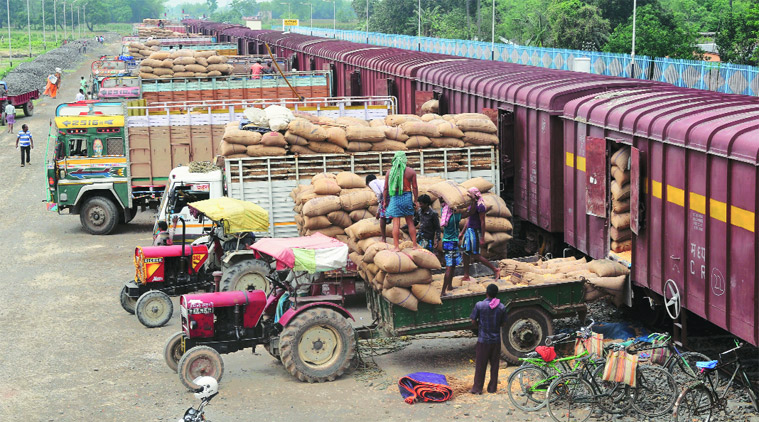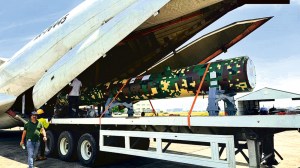- India
- International
Dipping prices, sudden cyclone disrupt Bihar farmers’ dream run with maize
Tuesday night’s thunderstorms with strong winds at 150-200km per hour have only added to farmers’ woes.
 Maize being loaded on a train near Purnia, hours before the storm.
Maize being loaded on a train near Purnia, hours before the storm.
For nearly a decade, Bihar’s farmers had a dream run with maize following new yield-enhancing hybrid seeds technology and rising crop realisations fuelled by export demand. But this dream has now begun to sour — prices started dropping from last year and now, cyclonic thunderstorms have ravaged the Kosi-Seemanchal belt just when the standing rabi crop was ready for harvesting.
Also Read: From mango to sugar, it’s a bitter story
Between 2005-06 and 2012-13, India’s maize exports soared over ten-fold from 4.2 lakh tonnes (lt) to 47.88lt. In value terms, the increase was even more — from US$71.38mn to US$1.31bn. Even in 2013-14, 39.79lt of grain worth US$1bn was shipped out.
Also Read: Wheat crop damaged, only seeds of discord at Punjab’s mega mandi
“That was a good time, as we were barely getting Rs 400 per quintal till 2005 during the harvest period from April to July. This rose to Rs 700-750 in 2006 and to Rs 1,200 in 2012. Even in 2013, prices were reasonable at Rs 1,100-1,150 per quintal,” said Vinod Choudhary, a 60-acre farmer from Damaili village in the Dhamdaha block of Purnia.

Also Read: Bihar storm toll rises to 48, farmers count losses
“I could get two of my daughters married only because of the makka (maize),” said Mohammad Mahir, a landless farmer from Bharri village in Katihar district’s Kadwa block. This father of four sons and three daughters grows rabi maize — sown from mid-October and harvested after mid-April — on 22 bighas (8.8 acres) under a ‘batai’ sharecropping arrangement in which a third of his produce goes to the landowner as lease rent.
Bihar’s maize farmers benefitted from the global commodity boom that led traders – especially multinationals like Cargill, Louis Dreyfus, Glencore, Noble Grain and Bunge – to exploit the state’s potential as a sourcing base for exports.
In 2012-13, about 10lt of Bihar’s maize got exported, including 6.5lt to South-East Asia and the rest to Bangladesh and Nepal. In 2013-14, too, Bihar’s exports were estimated at 7lt despite shipments to South-East Asia falling to 3.5lt.
“The landed price of Indian maize at ports in Indonesia, Vietnam or Malaysia was US$300 or Rs 16,300 per tonne then. Even if you bought at Rs 12,500 from Purnia and added rail freight of Rs 1,500 to Visakhapatnam, port handling charges of Rs 1,000 and ocean freight of US$20 (Rs 1,090), exports were feasible,” said a trader from a major multinational firm.
Moreover, Bihar was strategically placed as its crop arrived in the markets by mid-May and was ready for shipping by end-May. The corn from Argentina or Brazil could not be shipped out before mid-June, with the voyage time to South-East Asian ports at 45 days compared to 20 days from Visakhapatnam or Kakinada.
This roughly two-month-long supply gap is what the rabi maize from Bihar and, to a lesser extent, Andhra Pradesh essentially filled.
Apart from export demand, technology — planting of single-cross hybrids — also played a part in the boon.
Bihar today has a 25-lakh packet (4 kg each) market for rabi hybrid maize seeds valued at Rs 250 crore. Although there are some 106 seed companies operating in the state, almost 80 per cent of the market is controlled by four multinationals: DuPont Pioneer, Monsanto, Limagrain and Syngenta.
Choudhary and Mahir are among the many in Bihar’s corn belt — mainly Purnia, Katihar, Bhagalpur, Khagaria, Madhepura, Saharsa and Samastipur — who harvest 50-55 quintals per acre. This is comparable to the 180-200 bushels (one bushel is 25.4 kg) grain yields that Midwest US farmers in Illinois, Iowa or Indiana get.
Between 2005-06 and 2013-14, Bihar’s rabi maize production more than doubled from around 10lt to 23lt.
But since last year, the tide has turned as global maize prices have crashed along with other commodities. “At current landed cost of US$195-200 per tonne in South-East Asia, the corresponding parity price for maize in Bihar will have to be below Rs 800 per quintal. That rules out any exports, barring the usual 3-3.5lt to Bangladesh and Nepal, mainly by road,” said the trader from the multinational firm.
The drying up of exports has, in turn, impacted crop prices. “Last year, I sold my crop at Rs 850-900 per quintal. I don’t know what it is going to be this time,” said Mahir.
When prices were Rs 1,200 per quintal, Bihar’s farmers could gross Rs 60,000 from 50-quintal yields per acre. After deducting costs of Rs 20,000, there was something left for even sharecroppers like Mahir from intensive cultivation of rabi maize hybrids based on Monsanto’s or DuPont’s proprietary germplasm.
“We are being squeezed by both falling prices and rising costs. I bought urea at a black-market rate of Rs 480 per 50-kg bag this season, compared to Rs 350 last year,” said Mahir.
Tuesday night’s thunderstorms with strong winds at 150-200km per hour have only added to farmers’ woes.
“The standing crop has lodged in many parts of Purnia, Katihar and Madhepura. The crop that is still in maturity stage and due for harvest after mid-May will particularly suffer yield loss. Besides, there would be discolouration and poor starch content in the grain,” said Pintu Singh, a commission agent at Purnia’s Gulabbagh mandi.
For farmers, the worst fear is of traders citing quality deterioration as a reason for bringing down prices. This happened last year when the crop was drenched by unseasonal rains in May. While prices in Gulabbagh at present are around Rs 1,200-1,250 per quintal – roughly Rs 1,100-1,150 at the farmer’s end – hardly a tenth of the crop has arrived in the market so far.
Apr 20: Latest News
- 01
- 02
- 03
- 04
- 05






































